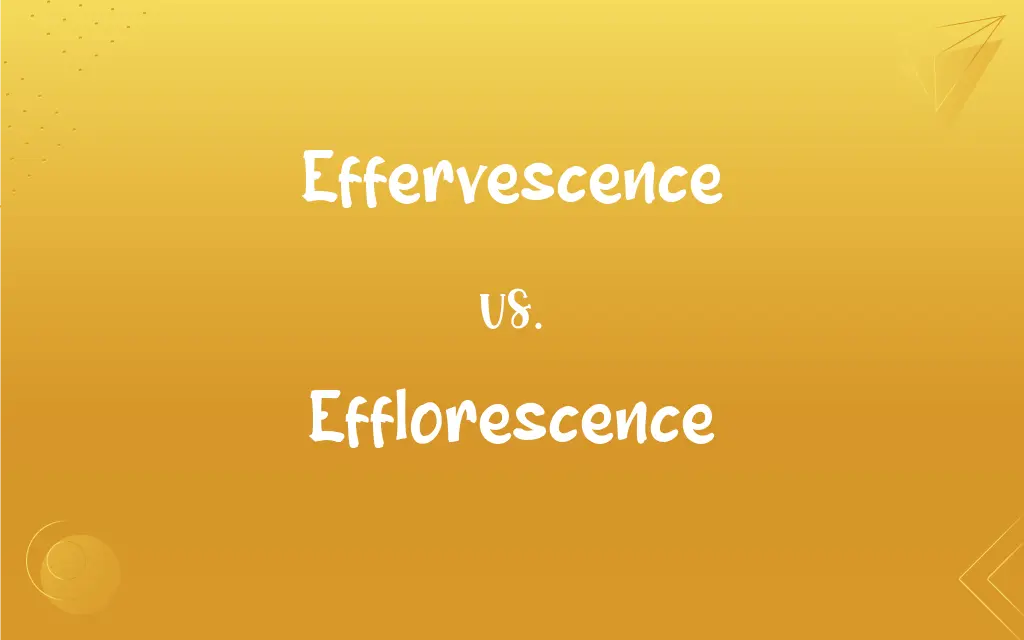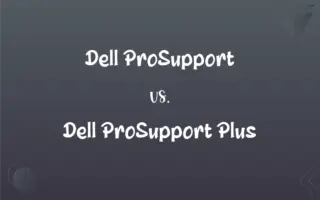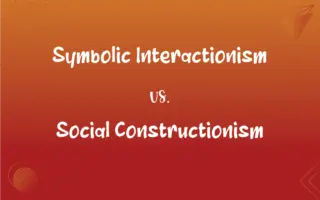Effervescence vs. Efflorescence: What's the Difference?
Edited by Aimie Carlson || By Janet White || Published on March 4, 2024
Effervescence is the release of gas bubbles in a liquid, while efflorescence is the migration of salts to the surface of a porous material.

Key Differences
Effervescence and efflorescence are distinct phenomena in science. Effervescence is a physical process involving the release of gas, often seen as bubbles in a liquid. It's a common occurrence in carbonated beverages or when acid reacts with a base. In contrast, efflorescence refers to a chemical process where water-soluble salts migrate to the surface of a porous material, like concrete or brick, and crystallize upon losing moisture.
The occurrence of effervescence is often temporary and dynamic, visible as it happens. It's a process typically observed in everyday life, such as fizzing in soft drinks or the reaction of vinegar with baking soda. Conversely, efflorescence is a gradual process, often noticed over time on buildings, walls, and pavements. It manifests as a white, powdery deposit on surfaces and is an indicator of moisture movement through material.
In terms of cause, effervescence is primarily due to the release of carbon dioxide gas either from a chemical reaction or from solution under reduced pressure. It is commonly associated with freshness or chemical activity. On the other hand, efflorescence is caused by the presence of soluble salts within materials and the movement of water. It often indicates a problem like improper drainage or moisture issues in masonry.
The impact of effervescence is generally neutral or positive, often desired in beverages for its sensory appeal. It is also used in effervescent tablets for faster dissolution of medication. In contrast, efflorescence can be a sign of underlying issues in construction materials, often considered undesirable as it can lead to damage or aesthetic issues in buildings.
Both effervescence and efflorescence involve a movement of sorts, their contexts are vastly different. Effervescence relates to gases in liquids and is often a sought-after quality, whereas efflorescence deals with salts in porous materials and is usually a problem indicating moisture issues.
ADVERTISEMENT
Comparison Chart
Definition
Release of gas bubbles in a liquid.
Migration of salts to the surface of materials.
Occurrence
In liquids, like carbonated drinks.
On surfaces of porous materials, like walls.
Cause
Gas release from chemical reaction or pressure.
Water movement and salt crystallization.
Visible Impact
Bubbles or fizzing effect.
White, powdery deposits on surfaces.
Implications
Often desirable, indicates freshness/activity.
Indicates moisture issues, often undesirable.
ADVERTISEMENT
Effervescence and Efflorescence Definitions
Effervescence
The release of gas bubbles in a liquid.
The effervescence in soda gives it a fizzy taste.
Efflorescence
Migration of salts to material surfaces.
Efflorescence appeared on the concrete foundation after heavy rains.
Effervescence
Formation of bubbles through chemical reaction.
Adding vinegar to baking soda creates effervescence.
Efflorescence
Crystallization of salts on surfaces.
Efflorescence caused white stains on the brick wall.
Effervescence
Rapid escape of gas from a liquid.
Effervescence occurs when opening a shaken soda can.
Efflorescence
Formation of salt deposits on masonry or concrete.
The basement walls showed signs of efflorescence, signaling water leakage.
Effervescence
Fizzing action in carbonated beverages.
The effervescence of champagne adds to its appeal.
Efflorescence
Salt residue on surfaces due to water evaporation.
Efflorescence was visible on the garden tiles during dry weather.
Effervescence
Bubbling effect in liquids due to gas release.
The effervescence in antacid water helps in quick relief.
Efflorescence
White powdery deposits on porous materials.
The efflorescence on the old church walls indicated moisture problems.
Effervescence
To emit small bubbles of gas, as a carbonated or fermenting liquid.
Efflorescence
(Botany) A state or time of flowering.
Effervescence
To escape from a liquid as bubbles; bubble up.
Effervescence
To show high spirits or animation.
Effervescence
The escape of gas from solution in a liquid, especially the escape of carbon dioxide from a carbonated drink.
Effervescence
Vivacity.
Effervescence
Foment.
Effervescence
A kind of natural ebullition; that commotion of a fluid which takes place when some part of the mass flies off in a gaseous form, producing innumerable small bubbles; as, the effervescence of a carbonate with citric acid.
Effervescence
The process of bubbling as gas escapes
Effervescence
The property of giving off bubbles
FAQs
What is effervescence?
Release of gas bubbles in liquids, like fizz in soda.
Can effervescence occur naturally?
Yes, in natural carbonated springs and fermenting liquids.
Are effervescence and efflorescence reversible?
Effervescence is usually a one-time event; efflorescence can sometimes be cleaned or prevented.
What does efflorescence indicate?
Presence of moisture and salts in materials, often a problem.
Is efflorescence harmful to structures?
It can be, indicating moisture problems that may damage materials.
Is effervescence used in medication?
Yes, in effervescent tablets for faster drug dissolution.
What causes efflorescence on brickwork?
Moisture movement bringing salts to the surface.
Can efflorescence occur indoors?
Yes, on walls and floors with moisture and salt presence.
How is effervescence beneficial in beverages?
Adds a sensory experience of fizz and taste enhancement.
Do all carbonated drinks show effervescence?
Yes, effervescence is a characteristic of carbonated beverages.
Can effervescence be artificially created?
Yes, through carbonation processes in beverages.
Can efflorescence damage paint and coatings?
Yes, it can cause peeling and discoloration.
How can efflorescence be prevented?
By using water-resistant materials and proper drainage.
Is effervescence always visible?
Generally yes, as it involves bubbling or fizzing.
Does efflorescence affect all building materials?
Mostly porous materials like brick, stone, and concrete.
What is the main concern with efflorescence?
It's a sign of potential moisture and durability issues.
Does efflorescence mean a building is unsafe?
Not always, but it indicates a potential moisture issue.
Can effervescence occur in non-alcoholic drinks?
Yes, any carbonated liquid can show effervescence.
What kind of gas causes effervescence?
Often carbon dioxide, but other gases can be involved too.
Is effervescence a chemical or physical process?
It's a physical process involving gas release.
About Author
Written by
Janet WhiteJanet White has been an esteemed writer and blogger for Difference Wiki. Holding a Master's degree in Science and Medical Journalism from the prestigious Boston University, she has consistently demonstrated her expertise and passion for her field. When she's not immersed in her work, Janet relishes her time exercising, delving into a good book, and cherishing moments with friends and family.
Edited by
Aimie CarlsonAimie Carlson, holding a master's degree in English literature, is a fervent English language enthusiast. She lends her writing talents to Difference Wiki, a prominent website that specializes in comparisons, offering readers insightful analyses that both captivate and inform.
































































